COLOMBIA – Or, Where I Learned to Just Go With the Flow
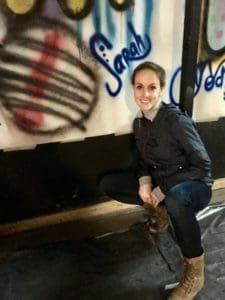 Colombia is a destination where you’ve got to roll with the punches, and we did just that. There was a general itinerary – but we learned very quickly that this was much more of a suggested “guideline”, rather than a set-in-stone plan. This is for a variety of reasons; from traffic in Bogotá, to extended periods of unexpected rain making certain attractions less than ideal to visit, but every change we made was one that enhanced our experience — rather than stubbornly sticking to our plan just to tick off our tourist Bingo boxes.
Colombia is a destination where you’ve got to roll with the punches, and we did just that. There was a general itinerary – but we learned very quickly that this was much more of a suggested “guideline”, rather than a set-in-stone plan. This is for a variety of reasons; from traffic in Bogotá, to extended periods of unexpected rain making certain attractions less than ideal to visit, but every change we made was one that enhanced our experience — rather than stubbornly sticking to our plan just to tick off our tourist Bingo boxes.
There are certainly “uncharted territories” in Colombia (more on that later), but even in the more developed tourist areas, a sense of adventure and flexibility is the key to a successful Colombian vacation. And when it comes to on-sites, Big Five has been in Colombia twice as long as their competitors, and I believe, the best situated to tackle the complexities of a country that is still emerging as a hot tourist destination.
Big Five operates in 44 countries, but Ashish, the current President and CEO, lives and breathes Colombia. After a “prospecting” trip over ten years ago, his passion for the country, its history, and its potential is extremely evident – and he (as well as everyone else we met in Colombia) passed that along to us.
Day 1
After a short sleep at the adequate, but certainly not luxurious, Miami Airport Hotel, I met the other members of our group at the Avianca counter in Concourse J to check-in for our direct flight to Bogotá.
Our group was relatively small – 9 agents including myself – and a great group of genuine, hilarious, and incredibly adventurous people.
The flight was fine; we were on an older Airbus 320, so there weren’t any seat-back personal televisions, and the seats were not all that comfortable. Perfectly adequate for a 3.5 hour flight, but I wouldn’t have wanted to be on it for much longer than that. Service was standard, on par with any domestic US flight I’ve taken; although we were served breakfast.
We landed in Bogotá on time and getting through Immigration was a breeze. After grabbing our bags, we were met by Big Five’s Country Manager Sandro and León, our guide for the first part of our journey.
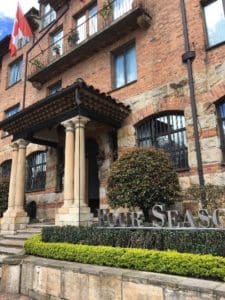 After a thirty-minute drive into Bogotá, in which we got to experience Bogotá traffic for the first time, we were welcomed by the Four Seasons Casa Medina for lunch. After Four Seasons took over Casa Medina, they transformed what used to be an open air internal courtyard into the property’s only restaurant Estanyoles – complete with a beautiful atrium for simulated al fresco dining. Our lunch consisted of a family style spread of Mediterranean-inspired dishes – I would have preferred something more authentically Colombian for our first meal, but the food was delicious, so I couldn’t really complain.
After a thirty-minute drive into Bogotá, in which we got to experience Bogotá traffic for the first time, we were welcomed by the Four Seasons Casa Medina for lunch. After Four Seasons took over Casa Medina, they transformed what used to be an open air internal courtyard into the property’s only restaurant Estanyoles – complete with a beautiful atrium for simulated al fresco dining. Our lunch consisted of a family style spread of Mediterranean-inspired dishes – I would have preferred something more authentically Colombian for our first meal, but the food was delicious, so I couldn’t really complain.
There are two Four Seasons properties in Bogotá, both former Charleston hotels, and I was on the list of participants staying at the new (two years old) Four Seasons Bogotá about a ten-minute drive away from Casa Medina. As opposed to Casa Medina, the Four Seasons Bogotá seems to be tailored more toward a business/corporate clientele (or families, as there are connecting room options). However, the property is still what I would call boutique-y: only sixty rooms.
I was given an Executive Suite on the top floor of Tower B (1 of 4 towers), which at 35 sqm, was more than enough space for a solo traveler. The bathroom is spacious, although only has one sink. Very large closet area leading into the bathroom. At this point, one of the biggest differences between this property and Casa Medina is that this property has air conditioning. Given Bogotá’s temperate and generally cooler climate due to its elevation, air conditioning is rarely necessary, but it’s no secret that the American market generally demands it.
As we were given a couple of hours free prior to our evening activity, I had wanted to check out the oxygenated pressurized fitness center – but ended up forgoing as I think the altitude had gotten to me a bit. Having never been at high altitude, I figured it was better to heed everyone’s advice and take it easy for the first couple of days.
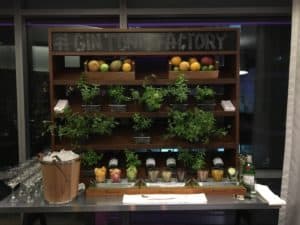 That evening, we headed over to the W Bogotá Hotel for a mixology experience and dinner. The W is a much larger hotel and located in the more commercial district. Very hip and swanky – but in true W style, the design is a bit too in-your-face for my taste. They were at a very high occupancy we only got to see an entry-level room, which at 35 sqm is an incredible amount of space for a lead-in category.
That evening, we headed over to the W Bogotá Hotel for a mixology experience and dinner. The W is a much larger hotel and located in the more commercial district. Very hip and swanky – but in true W style, the design is a bit too in-your-face for my taste. They were at a very high occupancy we only got to see an entry-level room, which at 35 sqm is an incredible amount of space for a lead-in category.
We were then whisked over to the Extreme Wow Suite (W’s version of a Presidential Suite), where an impressive spread of light bites was waiting for us. We got to customize our own Gin & Tonic with Colombia’s top mixologist/bartender and were also treated to a demonstration of how to make a couple of the W Lounge’s signature cocktails.
Day 2
Ashish wanted to make sure that we took it easy for the first day in Bogotá so as not to over-exert ourselves at an altitude most of us were not used to. So instead of following the planned itinerary, we pulled “audible” numéro uno and swapped the next two days’ activities. Instead of sticking around in central Bogotá, we headed North to Zipaquirá, where we visited the Catedral de Sal, or Salt Cathedral.
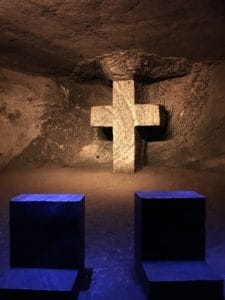 This is not your typical cathedral; this one was carved out of an old salt mine, where back when it was a functional mine, the miners built a small sanctuary within the expansive tunnels where they would perform their daily prayers (mining being quite a dangerous job, and most Colombians being generally quite pious). Over time, they expanded it until the construction jeopardized the integrity of the tunnels and the mine itself.
This is not your typical cathedral; this one was carved out of an old salt mine, where back when it was a functional mine, the miners built a small sanctuary within the expansive tunnels where they would perform their daily prayers (mining being quite a dangerous job, and most Colombians being generally quite pious). Over time, they expanded it until the construction jeopardized the integrity of the tunnels and the mine itself.
Construction on the cathedral that can be visited today started in the early 1990s, and the space is quite an impressive display of architecture. The pathway down to the three main naves showcases fourteen smaller chapels depicting the Fourteen Stations of the Cross, which are all interestingly lit and presented. The main cathedral area (the naves) is mostly frequented by tourists, but they did build a smaller “sanctuary” area off to the side where they have weekly services, attended by the local parishioners. Overall, I would definitely carve out the time to visit, as I found it to be a much more interesting experience than a run-of-the mill cathedral not 600+ feet underground!
Visiting the Catedral de Sal also gave us the perfect excuse to hit up the extremely eclectic Andrés Carnes de Res restaurant in Chía, about halfway between 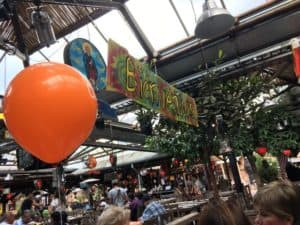 Zipaquirá and Bogotá. What started out as a small barbecue rest-stop restaurant has blossomed into a franchise whose location in Chía covers over 2 square miles… We were welcomed into a huge dining hall with decoration that I could only describe as very “Austin” (Texas). The atmosphere was fun and colorful, and the food was excellent – I mean, how can you go wrong with a giant plate of assorted meat? Even though it’s touristy now, locals still frequent it quite a lot (especially in the evenings) and I enjoyed going to a place where the food was more “Colombian” than you tend to get at 5-star hotels.
Zipaquirá and Bogotá. What started out as a small barbecue rest-stop restaurant has blossomed into a franchise whose location in Chía covers over 2 square miles… We were welcomed into a huge dining hall with decoration that I could only describe as very “Austin” (Texas). The atmosphere was fun and colorful, and the food was excellent – I mean, how can you go wrong with a giant plate of assorted meat? Even though it’s touristy now, locals still frequent it quite a lot (especially in the evenings) and I enjoyed going to a place where the food was more “Colombian” than you tend to get at 5-star hotels.
After our coma-inducing meatfest of a late lunch, we were basically done for the afternoon thanks to the lovely Bogotá traffic. I believe we finished lunch around 3:30 pm, which meant we got stuck in a good deal of rush-hour traffic on the way back to central Bogotá – a great time for a nap!
Upon arriving in Bogotá, we did speedy site inspections of the two Four Seasons properties. Casa Medina has a much more authentically Colombian vibe as its housed in a colonial-style mansion built in 1946. As it’s a historical building, the rooms are all different (even within the same category) – they are mostly the same size, but the layouts differ. Also, because of the historical status, the property has not been able to install air-conditioning without ripping out the beautiful exposed beams in the ceiling. To be perfectly honest, air conditioning is not necessary in Bogotá (known by Colombians as the “refrigerator” because it’s so much colder than the rest of the country due to the elevation), BUT we were informed that they will be working on installing AC unites by the end of this year.
The Four Seasons Bogotá (where I stayed) is lovely as well, but lacks the homey, traditional feel of Casa Medina. As a newer-build, there is more consistency in the layout and size of the room products, as well as a lot more connecting options for families.
Day 3
Today was our full day in Bogotá proper, but instead of visiting a bunch of churches and government buildings, we “did like the locals” and made our way over to the Mercado de Paloquemao, one of the largest markets in Bogotá. León got our group to weave through seemingly endless stalls of flowers (roses are a HUGE export in Colombia), exotic fruits, vegetables, fish, meat, and pretty much anything else you’d ever need to make or round out a meal.
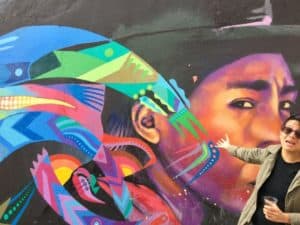 Then we made our way over the Candelaria neighborhood, where we met our expert-guide for the afternoon, Ana, who took us on a private Graffiti Tour of the area. Ana is a political science student who also moonlights as a street artist – and while we didn’t get to see any of her creations, she did walk us through some of the most iconic murals in Candelaria, all while explaining Bogotá’s history of graffiti & street art. Graffiti in Bogotá is now decriminalized, after a shocking incident when a 16-year-old was killed by police while in jail after tagging a building. Most Bogotanos now see graffiti as a legitimate art form, and it is widely supported.
Then we made our way over the Candelaria neighborhood, where we met our expert-guide for the afternoon, Ana, who took us on a private Graffiti Tour of the area. Ana is a political science student who also moonlights as a street artist – and while we didn’t get to see any of her creations, she did walk us through some of the most iconic murals in Candelaria, all while explaining Bogotá’s history of graffiti & street art. Graffiti in Bogotá is now decriminalized, after a shocking incident when a 16-year-old was killed by police while in jail after tagging a building. Most Bogotanos now see graffiti as a legitimate art form, and it is widely supported.
After seeing the street art up close and personal (and there are some amazing murals with great back stories), Big  Five had secretly arranged for us to join Ana in a “tagging class” – where we got to learn how to properly operate spray cans for optimal graffiti. I wouldn’t say any of us came out experts, as it’s surprisingly hard to free-hand with spray paint! Practice definitely makes perfect, but we had a blast with this very unique hands-on experience – and we were the first Big Fivers to test this out (our first experience as guinea pigs…with many more to come!).
Five had secretly arranged for us to join Ana in a “tagging class” – where we got to learn how to properly operate spray cans for optimal graffiti. I wouldn’t say any of us came out experts, as it’s surprisingly hard to free-hand with spray paint! Practice definitely makes perfect, but we had a blast with this very unique hands-on experience – and we were the first Big Fivers to test this out (our first experience as guinea pigs…with many more to come!).
With this extra activity, we ended using up our afternoon touring time (especially as the traffic prevents anyone from getting anywhere quickly in Bogotá), so we decided not to try to squeeze in a visit to the Museo del Oro. From all accounts, it’s one of the must-see museums in Bogotá; but we simply did not have time.
That evening we had dinner at JW Marriott hosted by ProColombia – the Colombian Tourism Board, who do an excellent and unique job of marketing Colombia as a tourist destination – they are a much more dynamic and fairly interesting Tourist Board than most. Their current marketing campaign highlights Colombia as the “land of sabrosura” – sabrosura is technically a made-up word to describe the rhythm and feeling of Colombia. It’s hard to describe, but this does as best of a job as any: https://www.youtube.com/watch?v=5ZZmGoG7_Yw .
Day 4
This day began our true “guinea pig” adventure, as we were off to the department of Huila (we’d be based in San Agustín), an area where there is, as of now, little-to-no North American tourism.
After a very early flight to Neiva (next to no traffic in Bogotá at 4 am!), the capital of the Huila department, we first drove north to the Tatacoa Desert – a stunningly beautiful landscape (and not something we expected to find in Colombia), and home to the Bethel Bio Luxury Hotel – which we got a chance to tour.
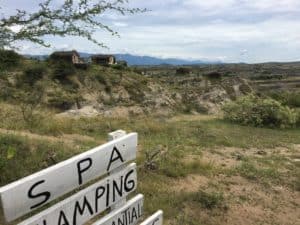 Definitely for the more adventurous traveler, Bethel is located pretty much in the middle of the desert and offers luxury “glamping” experiences – from a few typical rooms, to open-air Bio-Eggs, to the high-end and more spacious Eco Cavs – which are very much isolated from the rest of the spread out resort. The owner welcomed us personally (with mimosas!), and took us all around the property, all while expressing to us the importance of the resort in giving the local people employment options outside of FARC-controlled business. This is a sort of “rehabilitation” for regular Colombians who quite honestly got caught up in FARC business out of necessity – more on this later, but basically the only way to survive and make a living when Huila was completely controlled by the FARC was to cooperate with the guerillas.
Definitely for the more adventurous traveler, Bethel is located pretty much in the middle of the desert and offers luxury “glamping” experiences – from a few typical rooms, to open-air Bio-Eggs, to the high-end and more spacious Eco Cavs – which are very much isolated from the rest of the spread out resort. The owner welcomed us personally (with mimosas!), and took us all around the property, all while expressing to us the importance of the resort in giving the local people employment options outside of FARC-controlled business. This is a sort of “rehabilitation” for regular Colombians who quite honestly got caught up in FARC business out of necessity – more on this later, but basically the only way to survive and make a living when Huila was completely controlled by the FARC was to cooperate with the guerillas.
The property itself is quite stunning; and while a bit rustic, a pretty great experience for those who want to “get back to nature” without giving up a bit of luxury. We were told that the stargazing here is especially great.
We then made our way back to the nearest town, Villavieja, for lunch. Once we had filled our bellies with more exceptional, and very authentic Colombian fare, 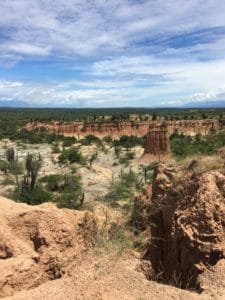 we mentally prepared ourselves for the seven(ish) hour drive south to San Agustín. Had we drove directly from Neiva to San Agustín it probably would have been more like five hours, but seeing the Tatacoa Desert was an experience I would not have given up!
we mentally prepared ourselves for the seven(ish) hour drive south to San Agustín. Had we drove directly from Neiva to San Agustín it probably would have been more like five hours, but seeing the Tatacoa Desert was an experience I would not have given up!
Normally the quickest and easiest way to get to San Augustín is by helicopter – but we had too many people for that, so off we went on our “guinea pig” adventure, driving on windy and at times, quite rough roads that would have been impossible just 5 years ago with a van full of North American tourists due to the prevalence of kidnappings for ransom by the guerillas. We liked to think of ourselves as pioneers bringing and promoting tourism to an area that is desperately trying to extricate itself from a very checkered past.
The long drives meant that we had plenty of time for a history lesson and León was more than happy to fill us in on Colombia’s past forty years. That was one of the most striking things about all the Colombians we met and spoke with – they know that their history is shocking and far from positive, but they do not shy away from talking about it or pretend it didn’t happen. The only way to learn from the past is to acknowledge it and move forward from there.
In a nutshell, (and I am not an expert, so please don’t quote me on this – I’m sure there’s a lot of nuances and details I missed) Pablo Escobar’s cocaine-based exploits created an incredibly violent network that wasn’t necessarily connected with the guerilla movements; however, after his death, there was a power vacuum that was easily filled by the Marxist guerilla forces. Kidnappings and murders were rampant, and their control grew so much that, at least in Huila, no one could do anything without permission from the guerilla commanders: buying land, opening a business, even marrying (at least from a couple people’s accounts) had to be run by the regional Commandante. And if the Commandante said no, that was basically the end of the discussion – unless you wanted to risk yours or a family member’s life. Real heavy stuff, especially our guides’ first-hand accounts of the times when their cousin or brother or neighbor was kidnapped…
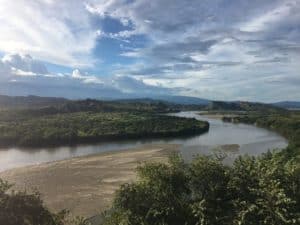 BUT to lighten our spirits, we stopped at several viewpoints along the way – the landscape is absolutely picturesque; really an untouched, beautiful region of the “real” Colombia. If you can handle the rough, bumpy roads and aren’t prone to car sickness, I definitely recommend making your way down to this region. Travel here has been made possible by the peace treaty that the Colombian government signed with the FARC in late 2016. It is not, by most accounts, a perfect treaty (there have not been harsh repercussions for FARC leaders), but it has at least stemmed the violence and given the Colombian people hope for a different future, which is a HUGE thing.
BUT to lighten our spirits, we stopped at several viewpoints along the way – the landscape is absolutely picturesque; really an untouched, beautiful region of the “real” Colombia. If you can handle the rough, bumpy roads and aren’t prone to car sickness, I definitely recommend making your way down to this region. Travel here has been made possible by the peace treaty that the Colombian government signed with the FARC in late 2016. It is not, by most accounts, a perfect treaty (there have not been harsh repercussions for FARC leaders), but it has at least stemmed the violence and given the Colombian people hope for a different future, which is a HUGE thing.
We made it to Monasterio San Agustín around 9:30 pm. It’s not a luxury hotel – I’d put it around a 4-star as its lacking the traditional 5-star services and amenities, but it is cute, clean, and has charm and great potential. I can see it being similar to Blancaneux in a couple years’ time – keeping the rustic charm but getting a bit more polished for the North American clientele they are trying to attract. The GM, Kenny, is wonderful – he came from Venezuela where he used to manage hotels there – and extremely attentive, along with the rest of the staff.
Day 5
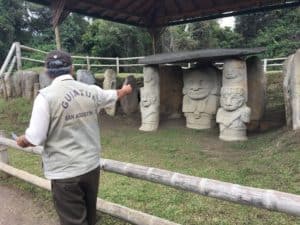 After a long day of traveling, you’d think that the last thing we’d want to do is be out and about for the whole day, but we were pioneers and super troopers – up early for breakfast, then piling back in our bus to drive over to the Parque Arqueológico – the main attraction of San Agustín.
After a long day of traveling, you’d think that the last thing we’d want to do is be out and about for the whole day, but we were pioneers and super troopers – up early for breakfast, then piling back in our bus to drive over to the Parque Arqueológico – the main attraction of San Agustín.
In addition to our national guide León (who had made the trip with us from Bogotá), we had a regional guide in San Agustín as well – this is generally because the majority of regional guides in San Agustín do not speak English (actually very few of the San Agustínians spoke English), and the national guide acts as a translator. However, we hit the jackpot in Marino – who was not only an amazing guide and incredibly passionate about his home, but also spoke pretty good English! He was also very engaging, and you could tell how important it was to him that we as North Americans had come to San Agustín; he did everything possible to show us the potential of the region as a tourist destination without being pushy or disingenuous.
The Parque Arqueológico San Agustín is essentially an outdoor museum showcasing the hundreds of pre-Colombian sculptures that have been unearthed in the area. It is widely believed that these sculptures were part of a giant necropolis (although there isn’t much conclusive evidence of anything about who created these since no writings have been found.
We had lunch at a small restaurant close to the Parque’s entrance, and after some exceptional food we drove over to the viewpoint for the Salto del Mortiño, one of the impressive waterfalls in the area, and then to Alto de la Piedras, another archaeological site outside of San Agustín. This site, nestled high up in the hills, is less frequented by tourists, and the statues are even more detailed and seemed to be as more well preserved.
By this time in the afternoon we were all quite exhausted (more from the previous day’s travel than anything else), and thus we headed back to the hotel for a little R&R – no spa, but showers and power naps were just enough – before dinner.
We had dinner at the restaurant at Monasterio San Agustín, where we were treated to some local live music, as well as an informal presentation and Q&A with Ivan, one of the regional “handlers” (he rode everywhere with us in our bus, as well as coordinated all of our activities). Ivan has lived in the region his entire life and was gracious enough to share his experience living under (unofficial) FARC rule.
Day 6
Originally, the plan was to get up early again and drive to Popayán (about 5hours) for our flight to Cartagena via Bogotá….BUT the rains in the area made some of the roads connecting San Augustín & Popayán almost un-navigable, AND the Popayán to Bogotá flight that was supposed to be wide open suddenly was filling up fast – which meant that the possibility of some or all of us getting bumped as technically “non-paying” passengers was very real. After a lot of behind-the-scenes action, Ashish and the team came to our rescue with a private charter flight to Bogotá from the airstrip in Pitalito (30 minute drive from San Agustín).
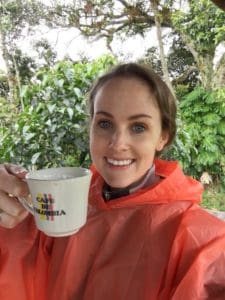 While the surprise of a private flight in lieu of another rough drive was a present enough, it also meant that we had an extra couple of hours in the morning to discover more of San Agustín and one of its many riches: coffee. While the region known as the “Coffee Triangle” in central Colombia is the most popular and developed for tourism, the coffee produced in the Huila department has, for the last 2-3 years, been recognized in Colombia as the best.
While the surprise of a private flight in lieu of another rough drive was a present enough, it also meant that we had an extra couple of hours in the morning to discover more of San Agustín and one of its many riches: coffee. While the region known as the “Coffee Triangle” in central Colombia is the most popular and developed for tourism, the coffee produced in the Huila department has, for the last 2-3 years, been recognized in Colombia as the best.
We visited a small family-owned & operated coffee farm (only three year-round workers, twenty-five during the major harvest in October/November), where the owner taught us all about the coffee making process – there are A LOT of steps that go into making enough beans for one cup of joe! One of the most interesting parts was learning about the importance of planting other trees & bushes around the coffee plants (including oranges, bananas, baloo – a legume, pineapples, etc.) to draw away insects from the coffee plants and/or to enrich the soil so they don’t have to use pesticides or fertilizer.
Hanging out at the Pitalito Airport (more like an airstrip with a small building with maybe two “gates”) and watching our Beechcraft land and taxi in was pretty surreal for someone who’s never flown on a private plane before! The flight itself took a little less than an hour and was much preferred to another bumpy & windy drive! After landing, we were bussed over to the main terminal, said goodbye to León and Sandro, and checked in for our commercial flight to our final destination: Cartagena!
Once again, Big Five spoiled us in the guide department: we were met in Cartagena by the effervescent, always smiling Vicky! It only took about a twenty-minute drive to get into the walled city and ultimately to our home for the remainder of the trip: Casa San Agustín, where we received an extremely warm welcome from Carolina and every other staff member.
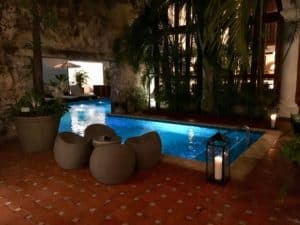 Casa San Agustín is 31 rooms in an old colonial house; very boutique, and VERY homey. The majority of their room inventory are Deluxe Rooms but given the building’s listed status and the limitations to modifications and renovations, all have different layout. Generally, the rooms with smaller square footage have a terrace, some have more square footage but lack natural light. I had what I deemed the attic room: I had a staircase all to myself leading up to my room, which was pretty cool (if you like stairs and are physically able to walk up them), but the room’s location within the building meant that I didn’t have any windows, therefore no natural light. The hotel has beautiful common areas – the pool is gorgeous – as is the room décor, but if you have specific needs or wishes as to the layout or room features, make sure you communicate those to the property ahead of time, so they can allocate an appropriate room.
Casa San Agustín is 31 rooms in an old colonial house; very boutique, and VERY homey. The majority of their room inventory are Deluxe Rooms but given the building’s listed status and the limitations to modifications and renovations, all have different layout. Generally, the rooms with smaller square footage have a terrace, some have more square footage but lack natural light. I had what I deemed the attic room: I had a staircase all to myself leading up to my room, which was pretty cool (if you like stairs and are physically able to walk up them), but the room’s location within the building meant that I didn’t have any windows, therefore no natural light. The hotel has beautiful common areas – the pool is gorgeous – as is the room décor, but if you have specific needs or wishes as to the layout or room features, make sure you communicate those to the property ahead of time, so they can allocate an appropriate room.
Day 7
This day was our only full day in Cartagena – so we packed a lot in!
I believe our first stop was supposed to be the Mercado de Bazurto but it had been raining overnight and into the morning, so Ashish and co. decided against making us slop through a busy, muddy market (audible #4657?). Instead, we got a bit of extra time to enjoy breakfast at Casa San Agustín, where Ashish had invited a couple representatives from the small fishing village La Boquilla, about 20 minutes outside Cartagena. This area has become relatively popular for off-the-beaten track travelers to Cartagena, and the locals have started giving tours and the like. Big Five strives to give back to every community in each of the 44 countries they operate in, and in Colombia, the Spirit of Big Five Foundation has partnered with La Boquilla fisherman and their families in an effort to improve their lives through education and other missives. This morning, Ashish presented our guests with over 1000 paper straws — which may seem like a small gesture, but paper straws will replace the plastic ones used for tourists’ fresh coconut beverages in the area AND therefore cut down on the amount of non-biodegradable waste in La Boquilla.
After breakfast, we drove up to the Convento de la Popa, a Monastery and Church on one of Cartagena’s highest hills – giving a nice panoramic view of the city and sea. Then we went back down to sea level to the Castillo de San Felipe – Cartagena’s walled fortress used to defend the city back in the time when pirates were marauding around the Caribbean.
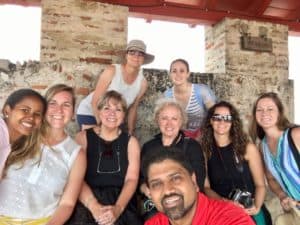 Once again, I have to applaud our guide Vicky – she is quite literally a “firecracker” : Very animated, always high energy, and just one of the sweetest people you could ever meet. Big Five is very selective with guides that they use for clients; in their mind there are only and handful in Cartagena that they trust fully and provide exceptional service to guests. So advance planning is necessary!! If you want a phenomenal guide like Vicky, make sure you request touring services WELL in advance. Honestly, the guide you have really shapes your experience, and it’s very important to use an on-site like Big Five that have vetted and hand-selected the best of the best. We were lucky to have absolutely lovely guides in León, Marino, and Vicky our entire trip, and some huge thanks goes out to Big Five for that!
Once again, I have to applaud our guide Vicky – she is quite literally a “firecracker” : Very animated, always high energy, and just one of the sweetest people you could ever meet. Big Five is very selective with guides that they use for clients; in their mind there are only and handful in Cartagena that they trust fully and provide exceptional service to guests. So advance planning is necessary!! If you want a phenomenal guide like Vicky, make sure you request touring services WELL in advance. Honestly, the guide you have really shapes your experience, and it’s very important to use an on-site like Big Five that have vetted and hand-selected the best of the best. We were lucky to have absolutely lovely guides in León, Marino, and Vicky our entire trip, and some huge thanks goes out to Big Five for that!
After meandering around the fortress and its tunnels for a while, we headed back to the Walled City, specifically the iconic Torre de Reloj to start our abbreviated 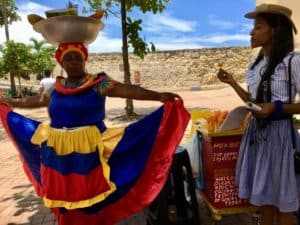 “Literary Menu of Gabriel Garcia Marquez”. This is a unique tour (that one the Big Five staff members and local guide actually made up a year or so ago on another Virtuoso FAM when the weather prevented them from doing their regularly scheduled activities) that combines the food & drink of Cartagena and the works of Colombia’s most celebrated author. The separate “Gabo guide” (dressed in period costume of course) would play excerpts of the novels, and then we would sample the food or drink mentioned in the excerpt – including sweets at the Portal de Los Dulces, fresh pineapple in the Plaza de San Pedro, limonada in Plaza Bolivar, and then finishing up with yucca empanadas at the quaint Mila Pasteleria. Our tour only lasted about an hour as we were doing our best to pack so much in one day, but the actual tour is about 3 hours and includes more in-depth explanations of the sights and Marquez’s works, and of course, more tastings!
“Literary Menu of Gabriel Garcia Marquez”. This is a unique tour (that one the Big Five staff members and local guide actually made up a year or so ago on another Virtuoso FAM when the weather prevented them from doing their regularly scheduled activities) that combines the food & drink of Cartagena and the works of Colombia’s most celebrated author. The separate “Gabo guide” (dressed in period costume of course) would play excerpts of the novels, and then we would sample the food or drink mentioned in the excerpt – including sweets at the Portal de Los Dulces, fresh pineapple in the Plaza de San Pedro, limonada in Plaza Bolivar, and then finishing up with yucca empanadas at the quaint Mila Pasteleria. Our tour only lasted about an hour as we were doing our best to pack so much in one day, but the actual tour is about 3 hours and includes more in-depth explanations of the sights and Marquez’s works, and of course, more tastings!
Having been held over with appetizers on our tour, we made our way over to the Sofitel Legend Santa Clara – probably the most well-known luxury hotel in Cartagena – for lunch and a site inspection.
The property is much larger than Casa San Agustín, with 120 rooms as opposed to just over 30, so finding space here is probably more likely. The historical building used to be a convent, and most of the Junior Suites and Suites are located here. There is an additional “Republican Wing” that is much more modern and resort-y feeling (and frankly has a lot less character), which houses the majority of the standard rooms.
Always running out of time (Cartageneros tend to be pretty laid back, and scheduled itineraries seem to go out the window), we rushed back to Casa San Agustín for about an hour of downtime to catch up on emails and the like before being whisked away again for our evening activities.
We started the evening at the bar & restaurant El Arsenal, where we had a private rum tasting of some of the establishment’s over 80 different types of rum (a large portion of which are from the local region and Colombia). Sufficiently liquored up, Big Five surprised us with our special pre-dinner activity: a private salsa lesson!
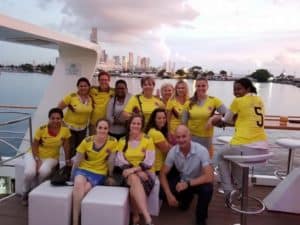 Back when we were in San Agustín, someone had mentioned that they’d love to be able to learn the basics of salsa while in Colombia, and guess what Big Five did? Not only did we learn salsa, but we got to do so on a yacht, at sunset, while cruising around the Cartagena port. An exceptional experience, to be sure, but that’s just a small testament to the level of detail and willingness to go above and beyond that epitomizes Big Five’s service.
Back when we were in San Agustín, someone had mentioned that they’d love to be able to learn the basics of salsa while in Colombia, and guess what Big Five did? Not only did we learn salsa, but we got to do so on a yacht, at sunset, while cruising around the Cartagena port. An exceptional experience, to be sure, but that’s just a small testament to the level of detail and willingness to go above and beyond that epitomizes Big Five’s service.
Finally, with our last minutes in Colombia ticking down, we made our way over to the rooftop of the Movich Cartagena de Indias hotel, hosted by ProColombia. We didn’t do a site of the hotel, but the rooftop is quite stunning and has the BEST views of the walled city – which are exceptionally beautiful at night.
Day 8
Saying goodbye to Colombia was quite difficult for all of us. As a group of world travelers, to say that Colombia had such an immense impact on every single one of us really goes to show how special this country and its people are. I would go back in a heartbeat, whether to other cities or regions like Medellin, the Caribbean desert of La Guajira, the Llanos Orientales region to see firsthand the psychedelic waters of Caños Cristalos, or even just back to the cities I already visited to delve deeper in the history and culture. And when I go back, I know who I want to take me there: Big Five. A simple “thank you” doesn’t seem to do it justice, but MUCHAS GRACIAS to Big Five, Avianca, ProColombia, and everyone else who made this trip possible; I had an amazing time and now encourage everyone I know to visit Colombia.

